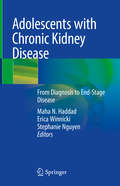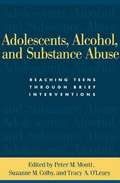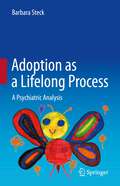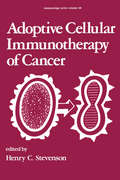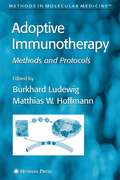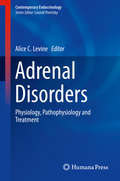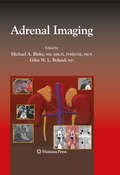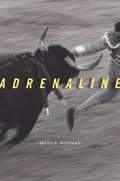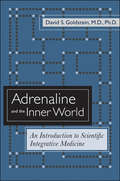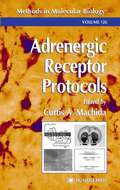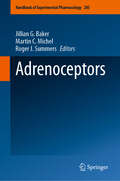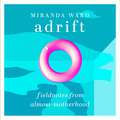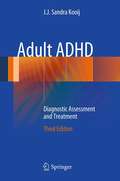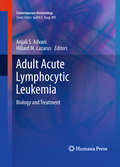- Table View
- List View
Adolescents with Chronic Kidney Disease: From Diagnosis to End-Stage Disease
by Maha N. Haddad Erica Winnicki Stephanie NguyenEnd-stage renal disease is a devastating diagnosis to the patient, family and their care provider. This book covers all aspects of chronic kidney disease from a general description to its psychological impact on the adolescent and lastly its progression to end-stage and dialysis. It details the important aspects of the patient’s journey from diagnosis to their final destination including transplant and discussion of the medications used. It includes chapters on important etiologies of chronic kidney disease in adolescence, addressing the particular challenges a provider may be faced with in caring for this age group, and finally transition of their care to adult care providers. Written by experts in the field of pediatrics and nephrology Adolescents with Chronic Kidney Disease is the definitive resource in diagnosing and transitioning patients with chronic kidney disease.
Adolescents, Alcohol, and Substance Abuse
by Peter MontiHow do substance abuse and dependence in adolescents differ from related problems in adults? Can treatment principles that work with adults be adapted successfully to meet the special needs of teens? This volume reviews a range of empirically supported approaches to dealing with alcohol and other drug problems in this large and diverse clinical population. The focus is on motivationally based brief interventions that can be delivered in a variety of contexts, that address key developmental considerations, and that draw on the latest knowledge about the processes of addictive behavior change. Bringing together a multidisciplinary group of expert contributors, this is an essential resource for anyone working with or studying adolescents at risk. Part I reviews current research on substance abuse in adolescents and young adults and outlines the basic principles of developmentally informed assessment and intervention. Contributors point out that admission to specialized treatment programs is relatively rare in today's health care climate, but there exist many opportunities for prevention, skills training, and harm reduction efforts. Emphasized are the benefits of working with young people on their "home turf" and reaching out to all individuals engaging in health-risk behavior, not just those seeking intensive treatment. Part II presents a range of specific interventions, including alcohol skills training; integrative behavioral and family therapy; motivational interviewing; interventions for dually diagnosed youth; Internet-based education, prevention, and treatment; and applications to HIV prevention. Chapters describe the goals and methods of these approaches, review available data on their efficacy, and offer case illustrations and clinical pointers. The volume concludes by outlining a broad agenda for future transdisciplinary investigation. Forging new connections among theory, research, and practice, this book belongs on the desks of all mental health practitioners and social service providers working with adolescents, as well as researchers and students in psychology, psychiatry, social work, and public health. It serves as a timely and relevant text for graduate-level courses. This volume reviews a range of empirically supported approaches to dealing with the growing problems of substance use and abuse among young people. While admission to specialized treatment programs is relatively rare in today's health care climate, there are many opportunities for brief interventions. Brief interventions also allow the clinician to work with the teen on his or her "home turf," emphasize autonomy and personal responsibility, and can be used across the full range of teens who are engaging in health-risk behavior. Bringing together a multidisciplinary group of experts, the volume reviews general principles of harm reduction and the stages of change, discusses developmental considerations, and outlines key components of assessment and intervention. Chapters then describe specific applications that can typically be implemented in one to five sessions, including alcohol skills training, integrative behavioral and family therapy, motivational interviewing, interventions for dually diagnosed youth, and use of the Internet for education, prevention, and treatment. The volume is extensively referenced and includes numerous clinical illustrations and vignettes.
Adoleszenz und Generationendynamik im Kontext von Migration und Flucht (Adoleszenzforschung #11)
by Vera King Susanne Benzel Hans-Christoph Koller Patrick Meurs Heinz WeißDas Buch widmet sich den psychosozialen Folgen von Migration und Flucht für Jugendliche und junge Erwachsene mit Blick auf gesellschaftliche Rahmenbedingungen und psychische Verarbeitungsformen. Adoleszente Generationendynamiken in Familien mit Migrations- oder Fluchtgeschichte werden analysiert im Lichte interdisziplinärer Verknüpfungen von Sozial- und Kulturwissenschaften, psychoanalytischer Sozialpsychologie, erziehungswissenschaftlicher Erforschung von Bildungsbiographien, Kinder- und Jugendpsychologie sowie klinischer Psychoanalyse und Psychosomatik.
Adopting After Infertility
by Marilyn Crawshaw Rachel BalenAround three quarters of people who turn to adoption do so because of infertility and those working in this field need information, guidance and support to assist them in the process of adoption to support the adopters and to deal with any issues that may result from infertility. Adopting after Infertility is an accessible and informative interdisciplinary book that addresses the issues that professionals working with adopters and the adopters themselves face when going through the adoption process and the impact of infertility on their experiences. The book includes chapters on the effects of infertility, why people may choose adoption and the assessment and preparation process. It also covers what an Adoption Panel needs to know about the prospective parents, the experiences of those coming to adoption from minority communities or when living with health conditions and post-adoption support needs. Personal accounts by people who have experienced adopting after infertility are included throughout the book. This book will be essential reading for professionals and academics from a range of disciplines including social work, psychology, health, mental health and counselling. It will also be invaluable to students studying for post-qualifying awards.
Adoption as a Lifelong Process: A Psychiatric Analysis
by Barbara SteckThis book addresses the psychosocial complexities of adoption from multiple perspectives, including the biological family, adopted child, and adoptive parents. It highlights the must-have sensitivity and tactfulness for recurring discussions of the adoption situation.Organized into 10 parts, the book begins with a brief outline of the history of adoption and its legal status from antiquity to modern times. Chapters in the first half of the book examine critical topics such as different parenthood situations, stress and pain processes in early childhood, and challenges of domestic, international, transcultural, transracial, foster, and sexual and gender minorities adoption. Within the second half of the book, chapters describe the birth parents' difficulties in relinquishing their infant, the motives of the adoptive parents, and the hardships of the adoptive children in self-development. The final chapters address the topic of deprivation, traumatization, and developmental trauma disorders on a psychodynamic level accompanied by clinical vignettes. Unique, perceptive, and insightful, Adoption, A Life Long Process is an essential resource for all of those involved in the adoption process, including counselors, psychologists, psychiatrists, social workers, adoptive parents, and biological parents.
Adoption: Changing Families, Changing Times
by Terry Philpot Anthony DouglasAdoption: Changing Families, Changing Times draws together contributions from all those with an interest in adoption: adopted people; birth parents and adoptive parents; practitioners and managers in the statutory and voluntary sectors; academics and policy makers. Chapters on research and policy are interspersed with those from people with first-hand experience of being adopted, becoming an adoptive parent or giving a child up for adoption. Together, they provide unique insights into a subject that although regularly in the media is often surrounded by prejudice and misconception. Topics covered include:* children and young people in care* trying to adopt* waiting for adoption* life after adoption* the politics of adoption.This accessible text offers a comprehensive view of adoption policy, practice and services and analyses why adoption has become so controversial. It provides professional and general reader alike with a fully rounded picture of adoption and exposes some of the myths surrounding it.
Adoptive Cellular Immunotherapy of Cancer
by H. C. StevensonThis volume presents the most complicated and powerful cancer biotherapies developed. It provides an overview of human immune system function and the mechanisms by which adoptive cellular immunotherapies (ACI) harnesses the activity. The volume provides a vision on the developments in ACI.
Adoptive Immunotherapy: Methods and Protocols (Methods in Molecular Medicine #109)
by Matthias W. Hoffmann Burkhard LudewigAn authoritative collection of optimal techniques for producing and characterizing the immunologically active cells and effector molecules now gaining wide use in the clinical treatment of patients. Taking advantage of the latest technologies, the authors present readily reproducible experimental protocols for the study of dendritic cells, T cells, monoclonal antibodies, and bone marrow transplantation. The emphasis is on preclinicical and clinical applications and on the progress of selected approaches in clinical trials. Additional chapters cover the molecular definition of target antigens, mathematical modeling approaches to immunotherapy, and the utilization of regulatory T cells. The protocols make it possible to study the adoptive transfer of tailored antigen-specific immune cells and to improve the clinical application of adoptive immunotherapy.
Adrenal Disorders: Physiology, Pathophysiology And Treatment (Contemporary Endocrinology)
by Alice C. LevineThis practical resource provides the latest evidence, management strategies and recommendations for the treatment of disorders of the adrenal glands, including related physiology, genetics and pharmacology. This book is divided into three thematic sections. The first covers adrenal physiology, presenting adrenal zonation and development, the regulation of steroidogenesis, and the pharmacology of glucocortisoids. Part two discusses the genetics and pathophysiology of a number of adrenal disorders, including autoimmune Addison's disease, congenital adrenal hyperplasia, primary aldosteronism, adrenocortical tumors and hyperplasias, and pheochromocytomas and paragangliomas. The final section presents the latest diagnostic and management strategies for these disorders, addressing adrenal insufficiency, adrenal Cushing's Syndrome and aldosteronism, among others. Over the past twenty years, our understanding of disorders of the adrenal glands has been altered and deepened. Providing a much-needed update to the literature, Adrenal Disorders: Physiology, Pathophysiology and Treatment will be an important resource for both academic and clinical endocrinologists working with the adrenal glands and managing patients with adrenal disorders.
Adrenal Imaging (Contemporary Medical Imaging)
by Michael A. Blake Giles BolandImaging of the adrenal gland has made tremendous progress in the last decade as new technologies continue to evolve. Adrenal Imaging highlights the pertinent clinical and pathological information that underpins the accurate interpretation and use of adrenal imaging. Written by a prestigious group of international contributors, individual chapters in Adrenal Imaging serve as a relevant and up-to-date reference of adrenal imaging findings, algorithms and techniques in CT, MR nuclear medicine, intervention and trauma. Summary sections at the end of each chapter illuminate key teaching points to enhance retention.
Adrenal Toxicology (Target Organ Toxicology Series)
by Philip W. Harvey David J. Everett Christopher J. SpringallDespite being regarded as the most common toxicological target in the endocrine system, the adrenal gland has often been neglected in regulatory testing. Adrenal Toxicology addresses the increased interest in adrenocortical toxicology and the need for a resource that makes techniques available to examine adrenal endocrine disruption. Examining curr
Adrenaline
by Brian B. HoffmanFamous as the catalyst of the fight or flight response, adrenaline has also received forensic attention as a perfect, untraceable poison-and rumors persist of its power to revive the dead. True to the spirit of its topic, Adrenaline is a stimulating journey that reveals the truth behind adrenaline’s scientific importance and popular appeal.
Adrenaline and the Inner World: An Introduction to Scientific Integrative Medicine
by David S. GoldsteinThis accessible work is the first in more than seventy-five years to discuss the many roles of adrenaline in regulating the "inner world" of the body. David S. Goldstein, an international authority and award-winning teacher, introduces new concepts concerning the nature of stress and distress across the body's regulatory systems. Discussing how the body's stress systems are coordinated, and how stress, by means of adrenaline, may affect the development, manifestations, and outcomes of chronic diseases, Goldstein challenges researchers and clinicians to use scientific integrative medicine to develop new ways to treat, prevent, and palliate disease. Goldstein explains why a former attorney general with Parkinson disease has a tendency to faint, why young astronauts in excellent physical shape cannot stand up when reexposed to Earth's gravity, why professional football players can collapse and die of heat shock during summer training camp, and why baseball players spit so much. Adrenaline and the Inner World is designed to supplement academic coursework in psychology, psychiatry, endocrinology, cardiology, complementary and alternative medicine, physiology, and biochemistry. It includes an extensive glossary.
Adrenergic Receptor Protocols (Methods in Molecular Biology #126)
by Curtis A. MachidaCurtis Machida and a panel of expert investigators present a comprehensive collection of modern molecular methods for analyzing adrenergic receptors and corresponding second messenger systems. These proven and readily reproducible techniques utilize genetic, RNA, protein expression, transactivator, and second messenger methodologies, as well as immunocytochemical, electrophysiological, transgenic, and in situ hybridization approaches. Each of the experts writing here details the use of their chosen method in examining the adrenergic receptor system, using aspects of the genetic flow of information as a guide: DNA ' RNA ' transactivator ' protein expression ' second messenger analyses ' cellular analyses ' transgenic whole animal approaches. Comprehensive and rich in practical detail, Adrenergic Receptor Protocols provides the first collection of readily reproducible methods for the study of these important regulators of CNS-mediated behavior and neural functions.
Adrenoceptors (Handbook of Experimental Pharmacology #285)
by Martin C. Michel Jillian G. Baker Roger J. SummersAdrenoceptors have been at the forefront of physiological and pharmacological research for a century. They served as prototypes for rationale drug design as recognized by a Nobel Prize to Sir James Black and for the molecular understanding and structure of G protein-coupled receptors as recognized by a Nobel Prize to Brian Kobilka and Robert J. Lefkowitz. Drugs directly or indirectly targeting adrenoceptors have become guideline-recommended treatments for more than 30 human and various animal diseases. This volume assembles leading experts on various types of adrenoceptor research to provide concise insight into the current standing and future direction of uses of adrenoceptor-targeted drugs and research in this field.
Adrenocortical Carcinoma: Basic Science and Clinical Concepts
by Gary D. Hammer Tobias ElseWe anticipate the book to be a definitive text on the subject that explores all aspects of the study of adrenal cancer and the treatment of patients with the disease. Chapters will cover epidemiology, pathogenesis, genetics, cancer stem cells, historic and emerging therapies, mouse models of adrenal cancer, new developments in tumor profiling, worldwide collaborative groups and tumor registries together with resources for the practitioner and community of adrenal cancer scientists. We do not wish this book to compete with the other larger books in the Endocrine and Endocrine Surgery literature. In addition, it is not expected to cover benign adrenal diseases that have been covered in detail in other venues. We envision this book to be a very specialized and exhaustive text on basic, translational and clinical aspects of adrenal cancer.
Adrift: Fieldnotes from Almost-Motherhood
by Miranda Ward'What would it mean to name this place I'm in, to map it? To say: this is the landscape. It looks like this, smells like this, at night these are the sounds that carry on the wind. Almost-motherhood . . .'When Miranda Ward and her husband decided to have a baby, they were young and optimistic. But five years, three miscarriages and one ectopic pregnancy later, she is still dealing with the ongoing aftermath of that decision, and the shadow it's cast over her relationship to her partner, her body and her future. In this searing, lyrical and radically honest memoir, Ward charts her journey through the uncertain landscape of almost-motherhood, asking questions of geography on the most intimate scale. How can we learn to be at home in our own bodies, even when we feel adrift from them? What language do we have for the spaces in between, the periods of wanting and waiting? And how do we maintain hope as we navigate towards an unknown future?
Adult ADHD: Diagnostic Assessment and Treatment
by J. J. KooijThis updated volume provides a clinical based overview of the assessment and treatment of ADHD in adults by a clinical researcher with extensive experience. Its practical focus allows each chapter to answer common questions encountered within clinical practice. Differential diagnosis of ADHD is also discussed in relation to comorbidity with bipolar disorder, borderline personality disorder, chronic fatigue syndrome, and chronic delayed sleep phase. Adult ADHD: Diagnostic Assessment and Treatment, fourth edition aims to help readers identify ADHD effectively and put in place suitable treatments. The book is relevant for psychiatrists, neurologists, and healthcare professionals involved in the diagnosis and treatment of adult ADHD.
Adult ADHD: Diagnostic Assessment and Treatment
by J.J. Sandra KooijAdult ADHD: Diagnostic Assessment and Treatment, Third Edition covers not only diagnostic assessment, but also comorbidity patterns as well as differential diagnosis of ADHD with for example bipolar disorder and borderline personality disorder. The symptom overlap and misdiagnosis of chronic fatigue syndrome in girls and women with the inattentive subtype of ADHD, ADD is explored. The chronic delayed sleep phase syndrome associated with ADHD based on disturbances in the circadian rhythm, and the possible consequences for general health (obesity, diabetes, cardiovascular diseases and cancer) are discussed. There are sections on ADHD and intelligence, criminality, sexuality, dyslexia and autism. Adult ADHD can be treated effectively but as yet the disorder is not always recognised by professionals and this book aims to help correct this. Diagnostic tools are included, such as the structured Diagnostic Interview for Adult ADHD (DIVA), and an ultra-short and somewhat longer screening tool, all based on the DSM-IV criteria for ADHD. Treatment options cover psychoeducation and motivation and individual and group coaching; long-acting stimulants and other new drugs for treating ADHD; use of melatonin to treat the delayed sleep-phase disorder. Useful information is included on the setting up and organisation of a department for adult ADHD with a multidisciplinary team. References, websites and useful international addresses have all been updated. Adult ADHD: Diagnostic Assessment and Treatment, Third Edition is intended for students, junior doctors/residents, psychologists, psychiatrists, other mental healthcare professionals and interested parties and provides a quick overview of the current state of the science and of the methods used in diagnosis and treatment. Adult ADHD: Diagnostic Assessment and Treatment, Third Edition was originally published by Pearson Assessment and Information BV, The Netherlands.
Adult ADHD: How to Succeed as a Hunter in a Farmer’s World
by Thom HartmannHow to harness your ADHD “hunter” strengths to start your own business and prosper in the workplace• Provides organizational strategies, tips to maintain focus, and tools to set goals, build a business plan, and discover the right project to keep you motivated• Shares ADHD success stories from Fortune 500 CEOs, inventors, small business owners, and the author’s own experience in launching new businesses• Explains the positive side of ADHD behavior in the context of creating a business, working within an existing company, and raising children with ADHDMost people do not “grow out” of Attention Deficit Disorder (ADD) or Attention Deficit Hyperactivity Disorder (ADHD). For many, their ADHD traits have led to difficulties in school, relationships, and work. But for our hunter-gatherer ancestors these characteristics were necessary for survival. Hunters must be easily distractible, constantly scanning their environment, and unafraid of taking risks. When humanity experienced the agricultural revolution 10,000 years ago, a vastly different type of personality--the methodical “Farmer”--became dominant. Most of our modern world is tailored to this Farmer personality, from 9-to-5 jobs to the structure of public schools, leaving ADHD Hunters feeling like unsuccessful outcasts. However, the Hunter skill set offers many opportunities for success in today’s Farmer society--if you learn how to embrace your ADHD traits instead of fighting against them.In this step-by-step guide, Thom Hartmann explains the positive side of Hunter behavior. He reveals how Hunters make excellent entrepreneurs, sharing ADHD success stories from Fortune 500 CEOs, inventors, small business owners, and his own hands-on experience in launching new businesses. Drawing on solid scientific and psychological principles, he provides easy-to-follow organizational strategies, tips to maintain focus and create a distraction-free workspace, and tools to set goals, build a business plan, and discover the right business project to keep you motivated. Hartmann shares valuable advice for both the Hunter entrepreneur and the Hunter within an existing company and for curtailing the aggressive side of the Hunter personality in group situations or manager positions. Revealing the many ADHD opportunities hidden within the challenges of work, relationships, and day-to-day life, Hartmann also includes tips on navigating family relationships and parenting--for most Hunter parents are also raising Hunter children.
Adult Acute Lymphocytic Leukemia: Biology and Treatment (Contemporary Hematology)
by Hillard M. Lazarus Anjali S. AdvaniThe current explosion of new areas of controversy in the treatment of acute lymphocytic leukemia in adults and young adults makes this comprehensive book a much needed reference for hematologists and oncologists. This book assembles leading authorities from around the globe to cover the full spectrum of ALL subtypes and their treatments. Specific topics of discussion include indications for allogeneic bone marrow transplant in first complete remission, the role of minimal residual disease in making treatment decisions, the treatment of young adults, and the treatment of Philadelphia chromosome positive ALL with the advent of the tyrosine kinase inhibitors. This is the first book to focus exclusively on the adult ALL patient. It provides a complete overview of diagnosis, molecular pathogenesis, evaluation, and treatment for this important patient population.
Adult Attachment Projective Picture System
by Malcolm L. West Carol GeorgeThis book presents cutting-edge research on adult attachment together with a complete overview of the Adult Attachment Projective Picture System (AAP), the authors' validated developmental assessment. In addition to identifying attachment classification groups, the AAP yields important information about dimensions--including defensive processes not evaluated by other available measures. Detailed case illustrations show what the AAP looks like "in action" and what it reveals about individuals' early experiences, sense of self, and capacity to engage in close, protective relationships. The AAP can be used in clinical or research settings; the concluding chapter discusses promising applications to studying the neurobiology of attachment.
Adult CCRN Exam Flashcards, Second Edition: Up-to-Date Review and Practice (Barron's Test Prep)
by Pat Juarez RN, MSBe prepared for exam day with Barron&’s. Trusted content from an Adult CCRN expert! Barron&’s Adult CCRN Exam Flashcards provides 425 up-to-date review and practice questions for all topics on the Adult CCRN Exam anywhere, anytime with this digital format.Written by an Experienced Educator and Nurse Learn from Barron&’s--all content is written and reviewed by an expert CCRN review course instructor and former clinical nurse specialist Build your understanding with review and practice tailored to the most recent exam blueprintDigital flashcard featuresAccess anywhere: study on all devices, including mobile--available online and offlineFlip functionality: a simple click flips cards from front to backRandom select: review cards in a random order rather than sequentiallyCheck out Barron&’s Adult CCRN Exam book for even more review, full-length practice tests, and access to Barron&’s Online Learning Hub for a timed test option and scoring.
Adult CCRN Exam Flashcards, Third Edition: Up-to-Date Review and Practice (Barron's Test Prep)
by Pat Juarez RN, MSBe prepared for exam day with Barron&’s. Trusted content from an Adult CCRN Exam expert!Barron&’s Adult CCRN Exam Flashcards includes 425 up-to-date content review and practice questions.Written by an Experienced Educator and NurseLearn from Barron&’s--all content is written and reviewed by an expert CCRN review course instructor and former clinical nurse specialist Build your understanding with review and practice tailored to the most recent Adult CCRN exam (also known as the Direct Care Pathway)Get a leg up with tips, strategies, and study advice for exam day--it&’s like having a trusted tutor by your sideBe Confident on Exam DaySharpen your test-taking skills with practice questions for all sections of the exam blueprint that reflect actual exam questions in format, content, and degree of difficultyDeepen your understanding by reviewing the detailed answer explanations that accompany all questionsStrengthen your knowledge with a review of all essential topics, including cardiovascular concepts, respiratory concepts, multisystem concepts, and much more, in an easy-to-follow outline format
Adult CCRN Exam Premium: Study Guide for the Latest Exam Blueprint, Includes 3 Practice Tests, Comprehensive Review, and Online Study Prep (Barron's Test Prep)
by Pat Juarez RN, MSBarron&’s Adult CCRN Exam Premium study guide provides all of the key concepts you need to pass the Adult CCRN exam, with detailed review and full-length practice tests plus online practice.This book features:A 25-question pretest to help pinpoint areas in need of intensive study needed to prepare for the Adult CCRN exam (also known as the Direct Care Pathway)Detailed subject reviews relevant to nursing, pediatric care, and critical care, including Cardiovascular Concepts, Pulmonary Concepts, Professional Caring and Ethical Practice Concepts, and more, in an easy-to-digest outline format, along with corresponding practice questions and answer explanationsTwo full-length practice CCRN tests in the book, each with 150 multiple-choice questions and fully explained answersOne full-length online practice exam with detailed answer explanations and scoringMore than 500 practice questions overall, for review and studyCCRN certification is a requirement in order to work in areas such as intensive care units, cardiac care units, combined ICUs/CCUs, medical/surgical ICUs, trauma units, or critical care transport/flight. CCRNs who have successfully passed the test report that self-study with sets of practice questions is an excellent strategy for success. Don&’t take chances with your CCRN certification—let Barron&’s CCRN book help you achieve the next level of professional achievement.
